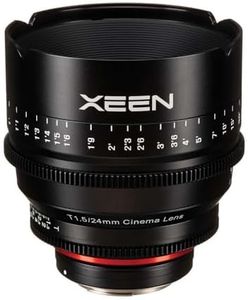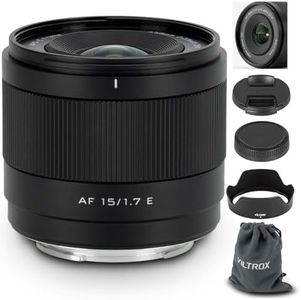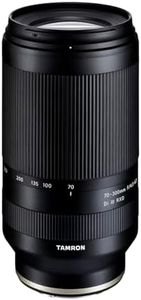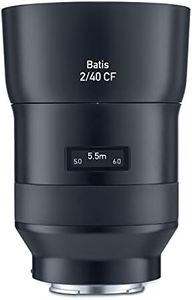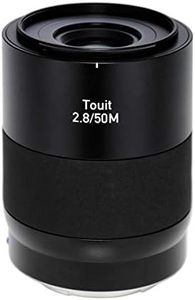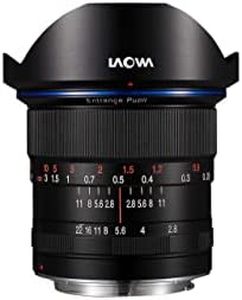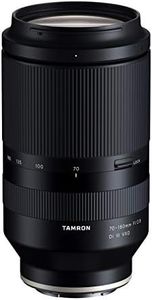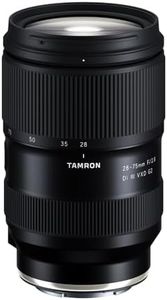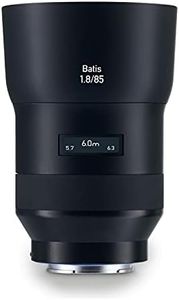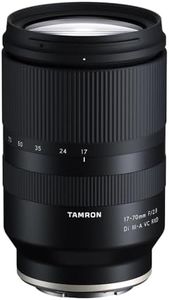We Use CookiesWe use cookies to enhance the security, performance,
functionality and for analytical and promotional activities. By continuing to browse this site you
are agreeing to our privacy policy
10 Best E Mount Lenses
From leading brands and best sellers available on the web.Buying Guide for the Best E Mount Lenses
Choosing the right E-mount lens involves understanding your photography or video needs and matching them with the lens's capabilities. E-mount lenses are made for mirrorless cameras, and your ideal choice depends on the subjects you want to shoot—like landscapes, portraits, sports, or macro photography. Getting to know the main lens specifications will help you select a lens that makes your camera versatile and perfectly tailored to your shooting style.Focal LengthFocal length is a number, measured in millimeters (mm), that tells you how 'zoomed in' a lens can be. Shorter focal lengths, like 16mm to 35mm, capture wide scenes and are great for landscapes, buildings, or groups of people, often called wide-angle lenses. Middle focal lengths, around 35mm to 85mm, are more natural for the human eye and work well for everyday use and portraits. Longer focal lengths, like 100mm and above, are 'telephoto' lenses and are used to bring distant subjects closer—ideal for sports or wildlife. Pick a wide-angle for sweeping views, a standard for general use, or telephoto for distant subjects, depending on your favorite subjects.
ApertureAperture refers to how wide the lens can open to let in light, shown by an f-number such as f/1.8, f/2.8, or f/4. A smaller number means a larger opening, which lets in more light, great for blurry backgrounds and shooting in dark conditions. Lenses with 'fast' (low-numbered) apertures like f/1.4 or f/1.8 are perfect for portraits and low-light, but are usually bigger and heavier. 'Slower' apertures, like f/4, are often smaller and lighter, suited for travel and bright conditions. Consider a lens with a wide aperture if you want background blur or often shoot indoors; otherwise, a narrower aperture can do the job and is easier to carry.
Image StabilizationImage stabilization minimizes blur caused by shaky hands, especially when shooting at slow shutter speeds or with long lenses. Some lenses offer built-in stabilization (often abbreviated as OSS, OIS, or IS). This is helpful for handheld shooting, especially in low light or with telephoto lenses. If you frequently shoot video or in darker places without a tripod, look for a lens with stabilization. If your camera already has in-body stabilization, you can be more flexible with lens choice.
Autofocus Type and SpeedAutofocus refers to how the lens can automatically focus on subjects. Some lenses use quieter, faster motors, making them suitable for both stills and video. If you photograph moving subjects—like sports, kids, or pets—choose a lens known for fast focusing. For video, silent and smooth autofocus motors prevent unwanted noise in your audio. If you mostly shoot stationary subjects, even slower autofocus is often fine.
Lens Size and WeightLens physical size and weight matter for comfort and portability. Larger, heavier lenses can be tiring during travel or long shoots but may offer better image quality and brighter apertures. Compact, lightweight lenses are easier to carry and handle, great for daily use and travel. If you want a kit that’s easy to bring everywhere, prioritize lighter, smaller lenses.
Weather SealingWeather sealing protects a lens from dust, moisture, and light rain, making it more durable in rough conditions. If you plan to shoot outside in unpredictable weather or nature, lenses with protective sealing are a smart choice. For indoor or studio shooting, this feature is less essential.
Minimum Focus DistanceMinimum focus distance is the closest you can get to the subject and still keep it sharp. Lenses with a shorter minimum distance are helpful for close-up and macro photography, like flowers, food, or small objects. If you love details and close shots, look for a lens with a short minimum focus distance.



